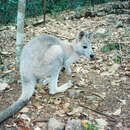en
names in breadcrumbs


Macropus robustus was described by Gould in 1839. One interesting aspect of wallaroos is what they choose as more important: water or shelter. In an experiment, scientists placed water tanks near rocky terrain and in open flat areas. They observed that hardly any visited the water tanks placed in the open flat areas, but they did frequent tanks near the rocky shelter. Another interesting result was that the water tank near the shelter attracted only 72% of wallaroos in that area; these were predominantly lactating females. This study showed that wallaroos placed shelter over free water and even when given the opportunity to obtain free water, they did not do so unless necessary. Strahan, 1995
Perception Channels: tactile ; chemical
In Victoria, wallaroos are in urgent need of protection. Due to their isolation, they are vulnerable to factors such as predation and human land development. In Victoria they are classified as rare. In all other areas that are known to contain wallaroos, however, the populations are abundant. Warneke, R.M. 1995. Mammals of Victoria: Distribution, Ecology and Conservation. Oxford University Press, Australia. 189.
US Federal List: no special status
CITES: no special status
IUCN Red List of Threatened Species: least concern
Wallaroos are vwell adapted to arid environments. Aside from their behavioral adaptations, wallaroos are interesting to scientists because of their physiological adaptations. Wallaroos have a very efficient excretory system that recycles nitrogen and urea to make a very concentrated urine. This physiological adaptation can provide scientists with much information about evolution of physiological characteristics. Tyndale-Biscoe, 1973; Warneke, 1995.
Positive Impacts: research and education
Wallaroos are herbivores that do not require much water or highly nutritious foods. They drink less frequently than most species in the family and eat foods that have lower nutritional value. They mainly feed on spinifex, soft grasses, shrubs, herbs and low protein/ low fiber grasses. In the spring they graze on grass inflourescences and forbs. Strahan, 1995; Tyndale-Biscoe, 1973.
Plant Foods: leaves
Primary Diet: herbivore (Folivore )
Inhabits most regions of Australia, including Central Australia, Cape York Penninsula of Queen Island in Northeastern Australia, the rocky areas of Hodgson in Northern Australia and the Victoria region.
Biogeographic Regions: australian (Native )
Macropus robustus is found in many regions of Australia. They can survive where the temperatures rises to 120 F and where the average rainfall is less than 380 mm/year. They prefer rocky places for shade and can inhabit regions of sparse vegetation. Strahan, 1995; Tyndale-Biscoe, 1973; Nowak, 1991
Terrestrial Biomes: desert or dune ; scrub forest
Average lifespan
Status: wild: 18.5 years.
Average lifespan
Status: captivity: 19.6 years.
Macropus robustus is one of the largest and heaviest of the macropodid family, with mature males attaining twice the weight of mature females. Wallaroos are stout and heavy with a head to tail length of 1138-1986 mm (males) and 1107-1508 mm (females). The tails are about 551-901 mm (males) and 534-749 mm (females). The pelage is darker (greyish-black) than most others in the Macropodidae, and it is of medium length and directed downwards. The fur is less dense than that of red and grey kangaroos and includes thin and sparse underfur. The color of the fur is dark grey on the dorsal side and pale to nearly white on the ventral side. The muzzle has a bare black rhinarium and a slight lateral inflation. The nasal region and the back of the ears are black, while the lips, the inside and base of the ears are white or pale. The legs and tail have a very dark brown color that bleeds into a black tint near the tips of both extremeties. The teeth have vertically placed roots in the second and third incisors. The second incisor has enamel that covers about the height and length of the crown. The outer face of the tooth has an indistinct groove. The third incisor is long and equals the combined length of the first and second incisors and also has an external notch near the front edge. The third premolar is about 7 mm in length and the fourth premolar is large and powerful. The molars have well developed transverse ledges with connecting ridges that are small and sometimes absent. The stance isdistinctive: the shoulders are thrown back, elbows tucked into the sides and wrists raised. Strahan 1995; Tyndale-Biscoe 1973; Nowak 1991
Range mass: 6.75 to 35.75 kg.
Other Physical Features: endothermic ; homoiothermic; bilateral symmetry
Sexual Dimorphism: male larger
Average basal metabolic rate: 33.056 W.
Wallaroos reach sexual maturity before two years of age. They are opportunistic breeders with no regular seasonal pattern of reproduction. Under good breeding conditions, nearly all females have one running offspring and one attached to a teat in the pouch. Under poor breeding conditions, females experience embryonic diapause. The gestation period is about 34 days and the pouch life ranges from 237-269 days. Strahan,1995; Tyndale-Biscoe, 1973; Thomas, 1888; Nowak, 1991
Key Reproductive Features: iteroparous ; year-round breeding ; gonochoric/gonochoristic/dioecious (sexes separate); sexual ; viviparous
Average birth mass: 0.703 g.
Average gestation period: 32 days.
Average number of offspring: 1.
Average age at sexual or reproductive maturity (male)
Sex: male: 670 days.
Average age at sexual or reproductive maturity (female)
Sex: female: 547 days.